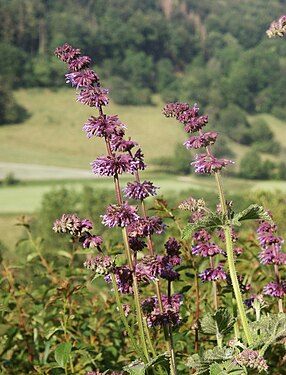Salvia verticillata
| Habit | herbaceous
| |
|---|---|---|
| Height: | ⇕ | 40 in"in" can not be assigned to a declared number type with value 40. |
| Width: | ⇔ | 32 in"in" can not be assigned to a declared number type with value 32. |
| Lifespan: | ⌛ | perennial |
| Bloom: | ❀ | early summer, mid summer, late summer |
| Exposure: | ☼ | sun |
|---|---|---|
| Features: | ✓ | flowers |
| USDA Zones: | 6 to 10 | |
| Flower features: | ❀ | blue, purple |
|
Salvia > |
L. > |
Salvia verticillata is a herbaceous perennial native to a wide area ranging from central Europe to western Asia, and naturalized in northern Europe and North America. It was first described by Carolus Linnaeus in 1753.[1]
Salvia verticillata has a leafy base of mid-green leaves covered with hairs, putting up leaf-covered stems that carry 3 ft m inflorescences. The tiny lavender flowers grow tightly packed in whorls, with tiny lime-green and purple calyces. The specific epithet verticillata refers to the whorls that grow in verticils. A cultivar introduced in the 1990s, 'Purple Rain', is much more showy and long-blooming, growing about 2 ft m tall.[1]
Read about Salvia verticillata in the Standard Cyclopedia of Horticulture
|
|---|
|
Salvia verticillata, Linn. Perennial, 2-3 ft. high: sts. herbaceous, erect, pilose-hispid: lvs., the base cordate, lyrate, the uppermost lobe the largest, ovate-rotund or entire, sinuate-crenate, both surfaces hispid or lanate; floral lvs. deflexed and bract-like: racemes branched, often a foot or more long; floral whorls 20-40-fld., remote; calyx villous, corolla lilac-blue, the tube included. July and Aug. Eu., Asia Minor and Caucasus region. CH
|
Cultivation
Propagation
Pests and diseases
Varieties
Gallery
References
- ↑ 1.0 1.1 Clebsch, Betsy; Carol D. Barner (2003). The New Book of Salvias. Timber Press. p. 298. ISBN 9780881925609. http://books.google.com/books?id=NM0iwB8GrQYC&pg=PA298.
- Standard Cyclopedia of Horticulture, by L. H. Bailey, MacMillan Co., 1963
External links
- w:Salvia verticillata. Some of the material on this page may be from Wikipedia, under the Creative Commons license.
- Salvia verticillata QR Code (Size 50, 100, 200, 500)



